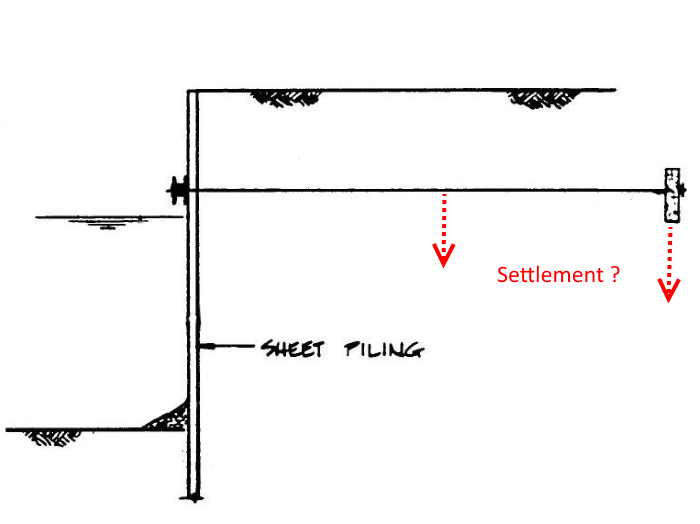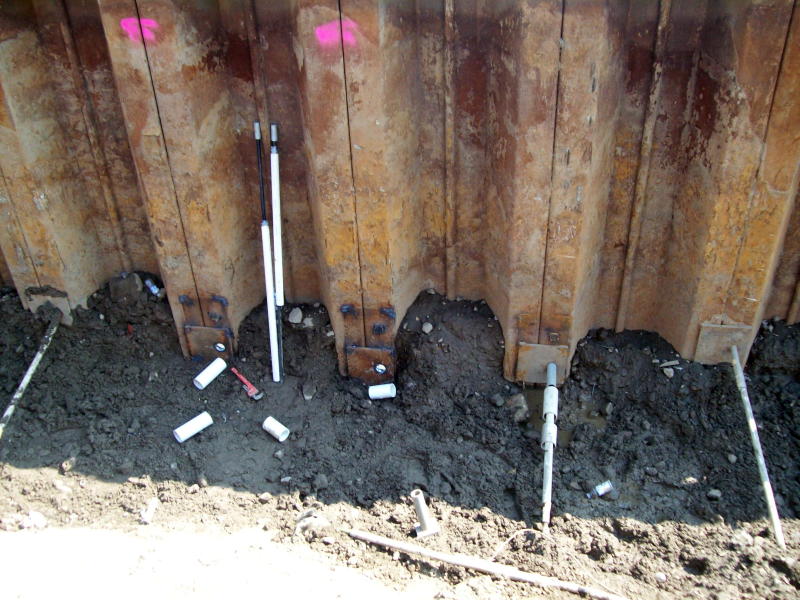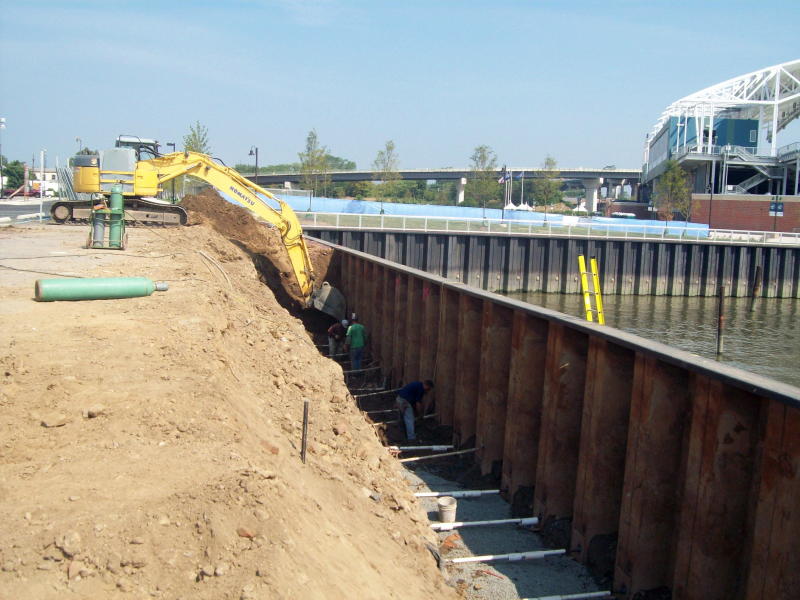I have been involved with the failure of tie-rods and bolts in steel sheet pile bulkhead design. In both cases the fasteners were designed to accommodate the concentric tensile forces with ample safety factor. It is apparent that the elements were subjected to combined stresses however because there is shear as a result of the soil atop the wale. Perhaps this is also bending. My question is has anyone else seen this and what are their thoughts? Thanks a bunch.
Navigation
Install the app
How to install the app on iOS
Follow along with the video below to see how to install our site as a web app on your home screen.
Note: This feature may not be available in some browsers.
More options
Style variation
-
Congratulations MintJulep on being selected by the Eng-Tips community for having the most helpful posts in the forums last week. Way to Go!
You are using an out of date browser. It may not display this or other websites correctly.
You should upgrade or use an alternative browser.
You should upgrade or use an alternative browser.
I have been involved with the failu 3
- Thread starter GSI2722
- Start date
- Status
- Not open for further replies.
SlideRuleEra
Structural
GSI2722 - I have not encountered failures, but would not be surprised with shear and/or bending due to excessive settlement of deadmen or tie-rod deflection from ambient soil settlement. Where I have worked soils are poor. Thoughts?

![[idea] [idea] [idea]](/data/assets/smilies/idea.gif)
![[r2d2] [r2d2] [r2d2]](/data/assets/smilies/r2d2.gif)

![[idea] [idea] [idea]](/data/assets/smilies/idea.gif)
![[r2d2] [r2d2] [r2d2]](/data/assets/smilies/r2d2.gif)
In the way I've typically done this (see SRE's sketch) it seems unlikely that you could develop sufficient load to shear off the bolts. With some napkin math, it seems like your bolt will start cutting through the soil, or deflecting a ridiculous amount, before it shears. If you haven't given it enough rotational freedom them maybe it could bind and fail in moment.
It sounds like you're saying the wale was on the soil side. In that case, it would be hard to provide compaction underneath the wale and you're likely supporting the soil above with the wale. Depending on the depth of the wale, you could conceivably shear off the wale to wall connectors and you would certainly have to design for that load.
Say you're 5 meters down. Your vertical pressure is probably around 100kPa. Say you have a 310mm wale. Your load is 31kN/m. Depending on your connection detail, that could certainly be significant.
It sounds like you're saying the wale was on the soil side. In that case, it would be hard to provide compaction underneath the wale and you're likely supporting the soil above with the wale. Depending on the depth of the wale, you could conceivably shear off the wale to wall connectors and you would certainly have to design for that load.
Say you're 5 meters down. Your vertical pressure is probably around 100kPa. Say you have a 310mm wale. Your load is 31kN/m. Depending on your connection detail, that could certainly be significant.
In addition to steel stresses by one means or anther, are you sure of your soil forces? Surcharge loads, moisture changes, such as dropping water tables can markedly affect stress in the rods. In such a case a geotech evaluation also is needed. Some common assumptions for lateral pressures can be way off from what actually happens. Is there any way to measure soil pressures now? Any way to check on construction techniques?
-
3
- #5
I was involved with a SSP bulkhead project (designed by someone else) where a good number of tie rods snapped off right behind the SSP wall. The wall did not have a wale. Each SSP double had its own tie rod. The plans called for placing a significant amount of fill behind the SSP in order to level off the area to create a parking lot. The fill was placed over soft river silts. The fill consolidated the soft river silts and the settlement bent the tie rods. The combined tension and unanticipated bending failed the rods. Test holes near the mid-length of the tie rods confirmed the amount of settlement. Knowing the amount of settlement, we could back calculate a uniform load required to bend the rods. Knowing the load, we could calculate the bending stress which we added to the tensile stress. The resulting total stress was enough to fail the rods. Essentially, at each end of a tie rod, I assumed that the stiffly connected tie rod ends were fixed, not pinned.
Whenever I design and/or place tie rods in a fill, especially when the fill is being placed over compressible, soft soil, I place the tie rods inside and at the bottom of a plastic pipe in order to allow some settlement before the tie rod bends. If the predicted settlement is significant, the pipe may need a large diameter also. Alternatively, the area may need to be surcharged (pre-loaded) to cause the settlement before the tie rods are placed (but nobody wants to do this).


Whenever I design and/or place tie rods in a fill, especially when the fill is being placed over compressible, soft soil, I place the tie rods inside and at the bottom of a plastic pipe in order to allow some settlement before the tie rod bends. If the predicted settlement is significant, the pipe may need a large diameter also. Alternatively, the area may need to be surcharged (pre-loaded) to cause the settlement before the tie rods are placed (but nobody wants to do this).


- Thread starter
- #6
Thank you all for your input. The explanation posted by PEinc seems to apply closely to the situations of failed rods I have encountered. I think I read somewhere, maybe US Sheet Pile Design Manual, that tie-rods should be sleeved but never incorporated it. It makes sense that soil pressures atop the rod would induce bending and probably also increase tension as the ends try to pull inward against the passive resistance of the backfill.
Thank you all and stay cool this weekend
Thank you all and stay cool this weekend
Another possible factor is progressive failure. Let's say one anchor moved, dumping load on nearby anchors. Thus, the subsequent failures and excessive loads applied can make an otherwise safe design go bad. I saw a grain bin fail when one or two bolts failed, followed by a zipper effect, dumping the whole storage of grain onto a railroad tipping over the train. Assuming uniform distribution of loads when many factors can affect that, is not a good idea.
- Status
- Not open for further replies.
Similar threads
- Question
- Replies
- 55
- Views
- 16K
- Question
- Replies
- 8
- Views
- 1K
- Question
- Replies
- 25
- Views
- 3K
- Question
- Replies
- 23
- Views
- 6K
- Question
- Replies
- 11
- Views
- 1K
